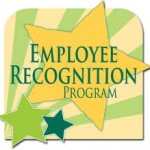In today’s workplace, it is more important now than ever to have an effective Employee Recognition Program.
The implementation of an effective employee recognition program can create a positive working environment that encourages employees to thrive. Recognition makes employees feel valued and appreciated, it contributes to higher employee morale, increases organizational productivity, and can aid in recruitment and retention. Recognition is a powerful motivator. It serves to reinforce the enthusiasm, commitment, and social conscience of employees and is a great vehicle for conveying the agency mission and goals.
What is most important in an award and recognition program?
To Senior Management
• Increases productivity
• Produces Return on Investment (ROI)
• Improves attitudes
• Builds loyalty and commitment
• Generates positive feedback
• Empowers the workforce
• Assures efficiency •
To Employees
• Creates a positive recognition experience
• Satisfies recognition needs
• Provides a wide selection of attractive, personalized awards
• Provides timeliness of recognition
• Guarantees quality of award
• Fosters open communication of appreciation
• Provides value for employees.
To Managers of Programs
• Includes efficient administration
• Excites employees
• Creates pride
• Pleases management
• Involves all employees
• Develops a partnership with the workforce
• Adds value for employees
The Role and Responsibilities of Managers
Managers can use recognition as a leadership tool. It can convey a strong message to employees regarding the work performance and behavior that is valued by their managers. By communicating these essential values, employees will understand how their performance directly contributes to the agency’s ability to achieve its goals.
The role of the Human Resource department is to:
• Provide policy review and interpretation;
• Initiate training for supervisors, managers, and award program coordinators in the implementation and delivery of the recognition program ;
• Serve as a resource and advocate to the organization on the employee award and recognition program; and
• Promote and communicate the award program to the organization.
Organization management, if feasible, ensures the availability of funds to support the costs incurred by the employee award and recognition program. Organization management is encouraged to:
• Allocate resources to implement the program and provide internal training for the award program.
• Promote and serve as an advocate for the organizations employee award and recognition program.
All levels of management should be well trained in the elements of recognizing and rewarding employees. It is essential that every manager and supervisor be aware of their responsibility to provide effective feedback and positive reinforcement to their employees. To cultivate a successful recognition program, all managers and supervisors should:
• Learn ways to motivate and inspire others;
• Learn how to communicate needs, expectations, and goals clearly;
• Explain how the program works and how employees can receive recognition; and
• Provide employees with an understanding of how they impact the organization’s goals, mission and success.
Developing a Successful Award and Recognition Program
Step One: Define the Program’s Scope and Direction
• What are the goals and objectives of the program?
It is important in the development of any employee recognition program that the goals and objectives, or what is hoped to be achieved, are understood by all those participating in the process. In order for a program to be cost effective and survive in the long-term, the results of the program must contribute to the achievement of the organizational mission. The award and recognition program should focus on acknowledging those accomplishments and behaviors that contribute to the organization’s mission and demonstrate organizational values. It should be cautioned that recognition of behaviors unrelated to the organization’s mission might lead to an ineffective program. These established program goals and objectives should clearly reflect the organization’s values, mission, and vision for the future. Examples of program goals may be:
• Improving safety
• Honoring long-term employment
• Acknowledging creativity that results in new and innovative procedures
• Recognizing excellent customer service
• Acknowledging employees of the week, month, quarter, or year
• Acknowledging positive attitudes
• Honoring highly skilled employees
• Honoring team players
• Honoring retiring employees
• Recognizing community volunteers
An organization may select any number of goals and objectives to suit their individual program.
Step Two: Develop a Budget
It is important to consider the impact of the Employee Award and Recognition Program on the organization’s budget. It is also important to remember that even with a limited budget, there are many ways to recognize employees with little or no cost. Depending on the amount of the allotment to the program, there are alternatives to fit any budget. The following considerations may be useful in developing a budget for the program:
• The potential number of award recipients in a set time frame;
• The types and subsequent costs of the awards;
• Costs associated with the presentation of the awards;
• The costs of promotional and informational materials;
• Administrative costs
• Costs associated with the training of managers and supervisors.
A list of award and recognition ideas are included at the bottom of this page.
Step Three: Establish the Program Guidelines
Employee Recognition Program Guidelines provide the basic parameters for which each organization can develop their own program. Agencies can recognize employees for: Distinguished Accomplishment; Sales, Length of Service; Innovation; Quality Management; Leadership, Volunteerism and much more. Organizations have flexibility in the types of awards or recognition given (monetary and non-monetary), and in the nomination and selection processes. You also have the option to set limits on the number of awards employees can receive in a fiscal year. Consideration should be given to the goals of the proposed program, as well as the scope and budget of the program.
The award program should be evaluated on a regular basis to ensure that program goals and categories continue to be effective, are fresh, and align with the work unit or organization objectives. The agency may want to consider surveying employees about the program to determine how well the program is being received throughout the organization.
Step Four: Choose the Awards
It is important to give some thought when choosing awards. The award or recognition should spark motivation and perhaps inspire employees to achieve the goals or to emulate the behavior that the award is associated with. During the development of a program that incorporates non-monetary and monetary awards, it is essential to take into account that some employees will be award recipients, while others will not be so fortunate. It is important to be aware of how a particular award functions within the work unit and the agency. There is potential to destroy the culture of a workplace if the recognition develops into a series of competitive contests, focusing on gifts and monetary awards, rather than on the recognized behaviors of employees. This situation can undermine the goals of the Employee Recognition program. Awards and recognition should have value and meaning to employees. The success of the program depends on employee buy-in. There are several methods of recognition that can be delivered to any one employee. It can be as simple as verbal praise or as elaborate as a tangible gift or monetary award and will likely result in increased productivity, motivation, and much more. A reward should be:
• Sincere: A reward should reflect a genuine expression of appreciation. Shallow acknowledgements leave something to be desired and are often mishandled.
• Meaningful: To elicit a motivating influence, rewards should be aligned with the values, goals, and priorities of the organization.
• Adaptable: A diverse workplace demands alternative recognition methods. Consider creative options to keep the program “fresh.” Remember, no single reward format works for everyone all the time.
• Relevant: Some personal dimension is essential to any good reward. No matter how formal or informal, expensive or affordable, the relevance of any recognition will be enhanced with a personal touch. It’s the little things that make a big difference.
• Timely: It is important that a reward addresses the behavior it is intended to reinforce. It is important not to let too much time pass or the reward may be devalued.
Step Five: Communicate the Program
Promotional materials and other methods of communication could be used to inform employees about the program. It is essential that employees are aware of the program and each award category that will be recognized. Program communication is essential from the start and should be an on-going effort. Promotional materials such as fliers, posters, brochures, bulletins, and postings on Intranet sites will remind employees of the program and of the potential recognition opportunities.
Step Six: Present the Awards
The presentation should match the significance of the achievement, and be worthy of the reason the employee is being recognized. Presentation of awards can be formal or informal. For example, the presentation may be made while one-on-one with the employee, in front of an immediate work unit, or at an agency-wide meeting. There are many possibilities. Just be sure to make the presentation worthy of the reason the employee is being recognized.
III. Award and Recognition Ideas
No or low cost recognition ideas
• Personal thank you notes or e-mails
• Write a letter of recommendation or commendation to be placed in the employee’s personnel file
• Free dress-down day
• Good deed awards
• Post on “recognition board” bulletin board, newsletters, and/or website
• Hall of Fame (photos of recognized employees)
• Submit an article about recipient to Intranet or Internet
• Submit an article about recipient to local/regional/national newspaper regarding employee’s achievement
• Begin a scrapbook that details achievements throughout the year—include photos
• Ask a senior manager to attend a staff meeting when recognizing employees for achievements
• Hold a recognition lunch
• An informal party (various foods and drink)
• Gift certificate to a local restaurant
• Traveling trophy
• Certificate or plaque
• Mugs, pens, tee shirts, etc. with team or agency logo
• Flowers
• Gift certificates for books or CDs
• Movie tickets
Moderate or higher cost recognition ideas
• Polo shirt with agency logo
• Planners
• Portfolios
• Business card holders
• Special name plate
• Gift certificates
• Trophy
• Clocks
• Cash
• Enrollment to seminar or additional training
• Catered lunch
• Annual picnic
• Membership choices to social or civic groups
• Month of free parking
• Office accessories
Please contact me if you need assistance in starting up or enhancing your Employee Recognition Program. I can also train managers on the importance of recognition in the workplace.


